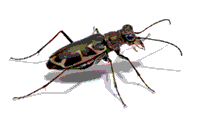Entomology, Department of

Department of Entomology: Faculty Publications
Document Type
Article
Date of this Version
2009
Abstract
In Nebraska, the ranges of Trimerotropis maritima (eastern species) and T. agrestis (western species) overlap but populations usually remain separated by habitat preferences. The morphological and color differences between the species are described. However, around Lake McConaughy, a reservoir on the North Platte River which has declined markedly in depth as a result of recent drought, a habitat was created in which the two species coincide and hybridize frequently. The water level in this reservoir had dropped in excess of 20 meters as of 2007, resulting in large expanses of dunes grading into beach habitats. Grasshoppers were collected in the area from 2005 to 2007 and based on morphological characteristics appear to represent hybrids. Surveys of many other habitats in Nebraska produced no hybrids. This study indicates that the alteration of habitat by impoundment of a river followed by climatic change may have the potential to disrupt environmental boundaries that maintain the integrity of parapatric sibling species. As this habitat is the result of human landscape alterations, it suggests that our alterations have the potential to disrupt environmental characteristics that maintain the integrity of parapatric sibling species.


Comments
Published in JOURNAL OF THE KANSAS ENTOMOLOGICAL SOCIETY 82(3), 2009, pp. 215–222. Copyright 2009 Kansas Entomological Society.